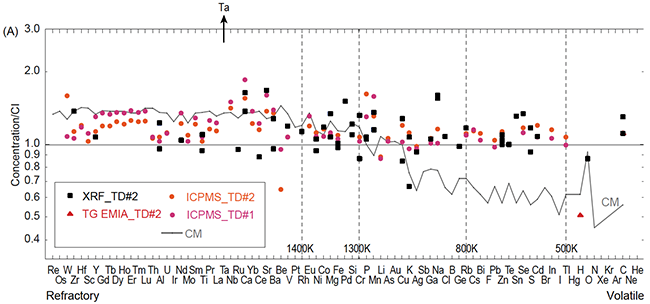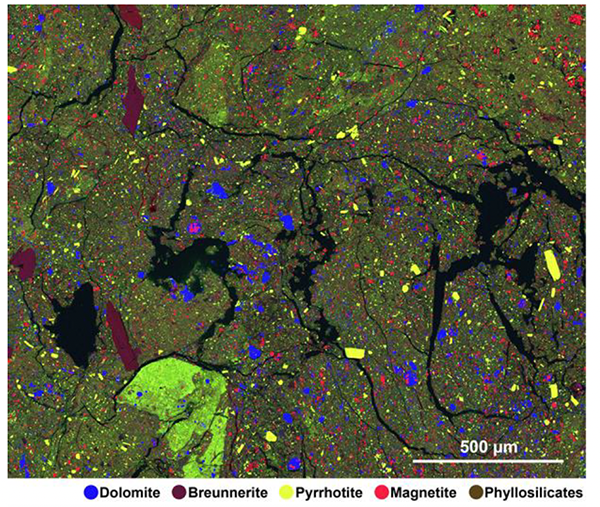NEWS
Samples returned from the asteroid Ryugu are similar to Ivuna-type carbonaceous meteorites
The team leader of the initial analysis for the Hayabusa 2 is Professor Tomoki Nakamura of the Graduate School of Science, Tohoku University. We will announce the results of the analysis when they are published as a paper.
The Hayabusa2 Initial Analysis Team is currently engaged in analysing the sample returned from asteroid Ryugu by the Asteroid Explorer Hayabusa2 Project. The Initial Analysis Team consists of six sub-teams and two Phase-2 curation institutions, Okayama University and the Japan Agency for Marine-Earth Science and Technology (JAMSTEC) Kochi Institute for Core Sample Research.
A summary of recent results from the Chemical Analysis Team in the Hayabusa2 Initial Analysis Team has been published in the American scientific journal, "Science", on June 10, 2022.
Initial analysis of the asteroid Ryugu sample
The sample from asteroid Ryugu returned to Earth by the asteroid explorer, Hayabusa2, on December 6, 2020, initially underwent a cataloguing description (Phase-1 curation) at the facility established at JAXA's Institute of Space and Astronautical Science. Part of the returned sample was distributed to the Hayabusa2 Initial Analysis Team, consisting of six sub-teams, and two Phase-2 curation institutes at Okayama University and JAMSTEC Kochi Institute for Core Sample Research. The initial analysis is designed to reveal the multifaceted features of the sample through a plan of high-precision analysis, with specialized sub-teams assigned to tackle the science objectives of the Hayabusa2 mission. Meanwhile, the Phase-2 curation institutes have specific specialties that are utilized to catalogue the sample based on a comprehensive analysis flow, and clarify the potential impact of the sample through measurement and analysis appropriate to the characteristics of the returned particles.
Reports from the six teams involved in the initial analysis, as well as those from Okayama University and JAMSTEC Kochi Institute for Core Sample Research, will be announced separately as the results are published in scientific journals. After the initial results have been released, a new overall summary of the Hayabusa2 science is planned.
Samples returned from the asteroid Ryugu are similar to Ivuna-type carbonaceous meteorites
1.Outline
Measurements have been conducted of the chemical and isotopic compositions of the sample returned by asteroid Ryugu by the Hayabusa2 mission. Ryugu was found to be comprised primarily of carbonaceous chondrites, especially the Ivuna-type carbonaceous chondrites known as CI chondrites. The main constituent minerals are secondary minerals that would have precipitated out from aqueous solution in the Ryugu parent body. The aqueous liquid in the parent body altered the primarily minerals that would have been originally present, and deposited the resultant secondary minerals during a time about 5 million years after the birth of the Solar System. The temperature during these changes was about 40℃, with pressures not exceeding 0.06 atm. Subsequently and to this day, the Ryugu sample is believed to not have been heated above 100℃. From these results, it can be concluded that the Ryugu sample has the most primitive characteristics without chemical differentiation of any natural sample available to humans, including the meteorites discovered so far. In the future, the Ryugu sample will be studied internationally as a new Solar System reference material.
2.Main text
The type of material that form asteroids has not yet been well understood. The first Hayabusa mission revealed that S-type asteroid is comparable to ordinary chondrite meteorites, demonstrating for the first time the direct relationship between asteroids and meteorites. Expanding on these results, Hayabusa2 conducted a sample return from the asteroid Ryugu, in order to clarify the relationship between C-type asteroids and meteorites. This paper is the first report in the series of initial analyses that were conducted.
This publication considered the (1) chemical composition, (2) isotopic composition, (3) origin of the constituents, (4) age of constituents, and (5) relationship to meteorites. Due to the wide range of research fields involved, the project is a collaboration between the Hayabusa2 Project Team, and the Astromaterials Science Research Group, as well as international teams that include prominent researchers from around the world.
X-ray fluorescence analysis, synchrotron radiation, scanning electron microscopy were used for the chemical composition analysis. Inductively Coupled Plasma Mass Spectrometry (ICP-MS), Thermal Ionization Mass Spectrometry (TIMS) and secondary ion mass spectrometry were used for the isotope analysis. The condition of the Ryugu sample used in these analyses were powder, granular, polished fragments, and chemically treated liquids.
The chemical composition of 66 elements (H, Li, Be, C, O, Na, Mg, Al, Si, P, S, Cl, K, Ca, Sc, Ti, V, Cr, Mn, Fe, Co, Ni, Cu, Zn, Ga, Ge, As, Se, Rb, Sr, Y, Zr, Nb, Mo, Ru, Rh, Pd, Ag, Cd, In, Sn, Te, Cs, Ba, La, Ce, Pr, Nd, Sm, Eu, Gd, Tb, Dy, Ho, Er, Tm, Yb, Lu, Hf, Ta, W, Tl, Pb, Bi, Th, U) was determined. The Ryugu sample was found to contain contamination from Ta (tantalum). The cause of this contamination was the use of tantalum projectiles used during the sample collection by the spacecraft, was expected and proves that the projectiles successfully fired. No contamination from other elements was observed, indicating that the sample had been handled in very clean conditions.
Figure 1 shows the analytical values for each element normalized by the CI chondrite value. Variations within each element arise from the heterogeneity within the sample, due to the small sample volume (approximately 30mg) that could be used for each analysis. Considering this heterogeneity, the averages sit on an almost horizontal line across all elements, indicating that the sample has the same concentration ratios as the CI chondrites. This horizontal line sits slightly above 1.0 due to the low hydrogen (H) plot (see below for reason).

Figure 1: Elemental abundances in the Ryugu sample, normalized to the analytical values of CI chondrites. Points that sit above (below) 1.0 are elements that are present in larger (smaller) quantities than in CI chondrites (©Yokoyama et al., 2022).
The chemical composition ratio of CI chondrites is thought to reflect that of the Solar System as a whole, making Ryugu the most primitive celestial body that has retained the chemical composition of the whole Solar System since its formation.
The isotopic ratios of Ti, Cr, and O in the Ryugu sample were also shown to be similar to that of CI chondrites. Further announcements on the isotopic ratios of the other elements will be made in the future.
An image from the scanning electron microscope analysis of the Ryugu sample is shown in Figure 2. Ryugu was found to be mainly composed of phyllosilicates (serpentine (Mg, Fe)3Si2O5(OH)4 and saponite Ca0.25(Mg,Fe)3((Si,Al)4O10)(OH)2·n(H2O)). Other major minerals are dolomite CaMg(CO3)2, breunnerite (Mg,Fe)CO3, pyrrhotite Fe1-xS, and magnetite Fe3O4. All of these minerals are formed via precipitates from aqueous solutions. Within the interior of Ryugu's parent body, the primary minerals would have been decomposed into these secondary minerals in aqueous solutions of melting ice. This phenomenon is called aqueous alteration. Aqueous alteration was so strong in the interior of the Ryugu parent body that few primary minerals now remain. This is also very similar to that of CI chondrites.

Figure 2: Constituent minerals of the Ryugu sample. All recognizable minerals in this figure are secondary minerals that were formed by aqueous alternation within Ryugu's parent body (©Yokoyama et al., 2022).
The age and temperature at which the aqueous alteration occurred were determined by the Mn-Cr dating and oxygen isotope thermometry. About 5 million years after the birth of the Solar System, aqueous alteration developed and deposited the secondary minerals. The temperature at this time was approximately 40℃, and the lower limit on the pressure was 0.06 atm.
Later, the present-day asteroid Ryugu was formed from the meteorite parent body. After the aqueous alteration, the Ryugu sample does not appear to have been heated above 100℃ at any time until the present day. However, most of the interlayer water that was contained between the layers of phyllosilicates evaporated into space. This is the major difference between the Ryugu sample and the CI chondrites. About half the water in the CI chondrites may be the result of contamination from terrestrial water vapour. If so, the material that makes up the CI chondrites, including organic matter, may have changed significantly from their original state when they were in space. This is an important perspective for future research.
These results indicate that the Ryugu sample is similar to CI chondrites. CI chondrites consist of only a few of the tens of thousands of meteorites that exist on the Earth. Such very rare meteorites came from C-type asteroids, which are abundant in the Solar System. Moreover, Ryugu retains more chemically primitive features than that of CI chondrites. This makes the Ryugu sample a primordial sample that is chemically closer to the average composition of the Solar System that any other natural sample that we have available to us. In the future, the Ryugu sample will be used around the world as a new Solar System reference sample.
3.Paper information
Paper title:
Samples returned from the asteroid Ryugu are similar to Ivuna-type carbonaceous meteorites
Authors:
Tetsuya Yokoyama1†, Kazuhide Nagashima2†, Izumi Nakai3, Edward D. Young4, Yoshinari Abe5, Jérôme Aléon6, Conel M. O'D. Alexander7, Sachiko Amari8, Yuri Amelin9, Ken-ichi Bajo10, Martin Bizzarro11, Audrey Bouvier12, Richard W. Carlson7, Marc Chaussidon13, Byeon-Gak Choi14, Nicolas Dauphas15, Andrew M. Davis15,Tommaso Di Rocco16, Wataru Fujiya17, Ryota Fukai18, Ikshu Gautam1, Makiko K. Haba1, Yuki Hibiya19, Hiroshi Hidaka20, Hisashi Homma21, Peter Hoppe22, Gary R. Huss2, Kiyohiro Ichida23, Tsuyoshi Iizuka24, Trevor R. Ireland25, Akira Ishikawa1, Motoo Ito26, Shoichi Itoh27, Noriyuki Kawasaki10, Noriko T. Kita28, Kouki Kitajima28, Thorsten Kleine29, Shintaro Komatani23, Alexander N. Krot2, Ming-Chang Liu4, Yuki Masuda1, Kevin D. McKeegan4, Mayu Morita23, Kazuko Motomura30, Frédéric Moynier13, Ann Nguyen31, Larry Nittler7, Morihiko Onose23, Andreas Pack16, Changkun Park32, Laurette Piani33, Liping Qin34, Sara S. Russell35, Naoya Sakamoto36, Maria Schönbächler37, Lauren Tafla4, Haolan Tang4, Kentaro Terada38, Yasuko Terada39, Tomohiro Usui18, Sohei Wada10, Meenakshi Wadhwa40, Richard J. Walker41, Katsuyuki Yamashita42, Qing-Zhu Yin43, Shigekazu Yoneda44, Hiroharu Yui45, Ai-Cheng Zhang46, Harold C. Connolly, Jr.47, Dante S. Lauretta48, Tomoki Nakamura49, Hiroshi Naraoka50, Takaaki Noguchi27, Ryuji Okazaki50, Kanako Sakamoto18, Hikaru Yabuta51, Masanao Abe18, Masahiko Arakawa52, Atsushi Fujii18, Masahiko Hayakawa18, Naoyuki Hirata52, Naru Hirata53, Rie Honda54, Chikatoshi Honda53, Satoshi Hosoda18, Yu-ichi Iijima18‡, Hitoshi Ikeda18, Masateru Ishiguro14, Yoshiaki Ishihara18, Takahiro Iwata18,55, Kosuke Kawahara18, Shota Kikuchi56, Kohei Kitazato53, Koji Matsumoto57, Moe Matsuoka18§, Tatsuhiro Michikami58, Yuya Mimasu18, Akira Miura18, Tomokatsu Morota24, Satoru Nakazawa18, Noriyuki Namiki57, Hirotomo Noda57, Rina Noguchi59, Naoko Ogawa18, Kazunori Ogawa18, Tatsuaki Okada18,60, Chisato Okamoto52‡, Go Ono18, Masanobu Ozaki18,55, Takanao Saiki18, Naoya Sakatani61, Hirotaka Sawada18, Hiroki Senshu56, Yuri Shimaki18, Kei Shirai18, Seiji Sugita24, Yuto Takei18, Hiroshi Takeuchi18, Satoshi Tanaka18, Eri Tatsumi62, Fuyuto Terui63, Yuichi Tsuda18, Ryudo Tsukizaki18, Koji Wada56, Sei-ichiro Watanabe20, Manabu Yamada56, Tetsuya Yamada18, Yukio Yamamoto18, Hajime Yano18, Yasuhiro Yokota18, Keisuke Yoshihara18, Makoto Yoshikawa18, Kent Yoshikawa18, Shizuho Furuya18, Kentaro Hatakeda64, Tasuku Hayashi18, Yuya Hitomi64, Kazuya Kumagai64, Akiko Miyazaki18, Aiko Nakato18, Masahiro Nishimura18, Hiromichi Soejima64, Ayako Suzuki64, Toru Yada18, Daiki Yamamoto18, Kasumi Yogata18, Miwa Yoshitake18, Shogo Tachibana65, Hisayoshi Yurimoto10,36*
Affiliation:
1Department of Earth and Planetary Sciences, Tokyo Institute of Technology; Tokyo 152-8551, Japan.
2Hawai'i Institute of Geophysics and Planetology, University of Hawai'i at Mānoa; Honolulu, HI 96822, USA.
3Department of Applied Chemistry, Tokyo University of Science; Tokyo 162-8601, Japan.
4Department of Earth, Planetary, and Space Sciences, University of California, Los Angeles; Los Angeles, CA 90095, USA.
5Graduate School of Engineering Materials Science and Engineering, Tokyo Denki University; Tokyo 120-8551, Japan.
6Institut de Minéralogie, de Physique des Matériaux et de Cosmochimie, Sorbonne Université, Museum National d'Histoire Naturelle, Centre National de la Recherche Scientifique Unité Mixte de Recherche 7590, Institut de recherche pour le développement; 75005 Paris, France.
7Earth and Planets Laboratory, Carnegie Institution for Science; Washington, DC, 20015, USA.
8McDonnell Center for the Space Sciences and Physics Department, Washington University; St. Louis, MO 63130, USA.
9Guangzhou Institute of Geochemistry, Chinese Academy of Sciences; Guangzhou, GD 510640, China.
10Department of Natural History Sciences, Hokkaido University; Sapporo 001-0021, Japan.
11Centre for Star and Planet Formation, Globe Institute, University of Copenhagen; Copenhagen, K 1350, Denmark.
12Bayerisches Geoinstitut, Universität Bayreuth; Bayreuth 95447, Germany.
13Université de Paris, Institut de physique du globe de Paris, Centre National de la Recherche Scientifique; 75005 Paris, France
14Department of Physics and Astronomy, Seoul National University; Seoul 08826, Republic of Korea.
15Department of the Geophysical Sciences and Enrico Fermi Institute, The University of Chicago; Chicago, IL 60637, USA.
16Faculty of Geosciences and Geography, University of Göttingen; Göttingen, D-37077, Germany.
17Faculty of Science, Ibaraki University; Mito 310-8512, Japan.
18Institute of Space and Astronautical Science / Jaxa Space Exploration Center, Japan Aerospace Exploration Agency; Sagamihara 252-5210, Japan.
19Department of General Systems Studies, The University of Tokyo; Tokyo 153-0041, Japan.
20Department of Earth and Planetary Sciences, Nagoya University; Nagoya 464-8601, Japan.
21Osaka Application Laboratory, Rigaku Corporation; Osaka 569-1146, Japan.
22Max Planck Institute for Chemistry; Mainz 55128, Germany.
23Analytical Technology Division, Horiba Techno Service Co., Ltd.; Kyoto 601-8125, Japan.
24Department of Earth and Planetary Science, The University of Tokyo; Tokyo 113-0033, Japan.
25School of Earth and Environmental Sciences, The University of Queensland; St Lucia QLD 4072, Australia.
26Kochi Institute for Core Sample Research, Japan Agency for Marine-Earth Science and Technology; Kochi 783-8502, Japan.
27Department of Earth and Planetary Sciences, Kyoto University; Kyoto 606-8502, Japan.
28Department of Geoscience, University of Wisconsin- Madison; Madison, WI 53706, USA.
29Max Planck Institute for Solar System Research; 37077 Göttingen, Germany.
30Thermal Analysis Division, Rigaku Corporation; Tokyo 196-8666, Japan.
31Astromaterials Research and Exploration Science Division, National Aeronautics and Space Administration Johnson Space Center; Houston, TX 77058, USA.
32Division of Earth-System Sciences, Korea Polar Research Institute; Incheon 21990, Korea.
33Centre de Recherches Pétrographiques et Géochimiques, Centre National de la Recherche Scientifique - Université de Lorraine; 54500 Nancy, France.
34School of Earth and Space Sciences, University of Science and Technology of China; Anhui 230026, China.
35Department of Earth Sciences, Natural History Museum; London, SW7 5BD, UK.
36Isotope Imaging Laboratory, Hokkaido University; Sapporo 001-0021, Japan.
37Institute for Geochemistry and Petrology, Department of Earth Sciences, ETH Zurich, Zurich, Switzerland.
38Department of Earth and Space Science, Osaka University; Osaka 560-0043, Japan.
39Spectroscopy and Imaging Division, Japan Synchrotron Radiation Research Institute; Hyogo 679-5198 Japan.
40School of Earth and Space Exploration, Arizona State University; Tempe, AZ 85281, USA.
41Geology, University of Maryland, College Park, MD 20742, USA.
42Graduate School of Natural Science and Technology, Okayama University; Okayama 700-8530, Japan.
43Department of Earth and Planetary Sciences, University of California; Davis, CA 95616, USA.
44Department of Science and Engineering, National Museum of Nature and Science; Tsukuba 305-0005, Japan.
45Department of Chemistry, Tokyo University of Science; Tokyo 162-8601, Japan.
46School of Earth Sciences and Engineering, Nanjing University; Nanjing 210023, China.
47Department of Geology, School of Earth and Environment, Rowan University; Glassboro, NJ 08028, USA.
48Lunar and Planetary Laboratory, University of Arizona; Tucson, AZ 85705, USA.
49Department of Earth Science, Tohoku University; Sendai, 980-8578, Japan.
50Department of Earth and Planetary Sciences, Kyushu University; Fukuoka 819-0395, Japan.
51Earth and Planetary Systems Science Program, Hiroshima University; Higashi-Hiroshima, 739-8526, Japan.
52Graduate School of Science, Kobe University; Kobe 657-8501, Japan.
53Department of Computer Science and Engineering, University of Aizu; Aizu-Wakamatsu 965-8580, Japan.
54Faculty of Science and Technology, Kochi University; Kochi 780-8520, Japan.
55The Graduate University for Advanced Studies, Sokendai, Kanagawa 240-0193, Japan
56Planetary Exploration Research Center, Chiba Institute of Technology; Narashino 275-0016, Japan.
57National Astronomical Observatory of Japan; Mitaka 181-8588, Japan.
58Faculty of Engineering, Kinki University; Higashi-Hiroshima 739-2116, Japan.
59Academic Assembly Institute of Science and Technology, Niigata University; Niigata 950-2181, Japan.
60Department of Chemistry, The University of Tokyo; Tokyo 113-0033, Japan.
61College of Science Department of Physics, Rikkyo University; Tokyo 171-8501, Japan.
62Instituto de Astrofísica de Canarias, University of La Laguna; Tenerife, Spain.
63Graduate School of Engineering, Kanagawa Institute of Technology; Atsugi 243-0292, Japan.
64Marine Works Japan Ltd.; Yokosuka 237-0063 Japan.
65UTokyo Organization for Planetary and Space Science, University of Tokyo; Tokyo 113-0033, Japan.
*Corresponding author. Email: yuri[at]ep.sci.hokudai.ac.jp
†These authors contributed equally to this work.
‡Deceased.
§Present address. Laboratoire d'études spatiales et d'instrumentation en astrophysique, Observatoire de Paris; 92195 Meudon, France.
Journal:Science
Contact:
Tomoki Nakamura
Email: tomoki.nakamura.a8 * tohoku.ac.jp
Website: http://www.esse.epms.es.tohoku.ac.jp/project-en.html
(Replace * with @)




